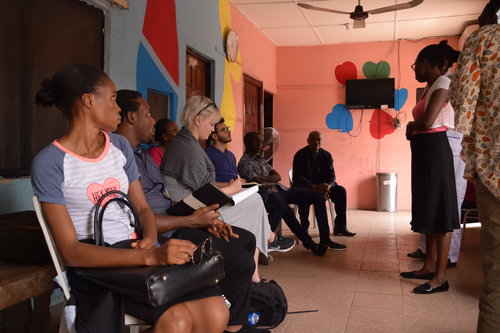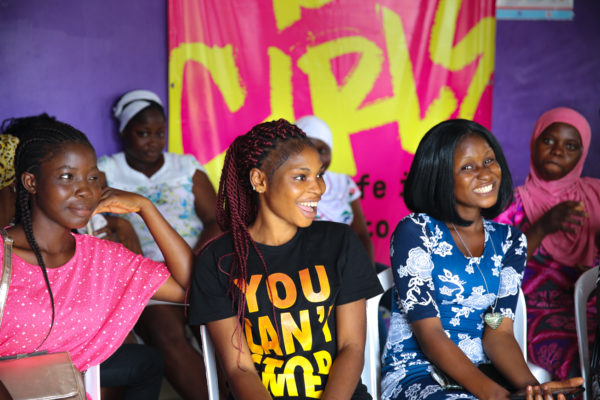By Kelly O’Keefe, Research Ethics Program Manager, PSI, Jennifer Wheeler, Deputy Director for Research, PSI, and Lee-Ann Gallarano, Program Manager for Evidence, PSI
Human-Centered Design (HCD) is the talk of the town. It’s an approach to designing a programmatic intervention that draws a solution from deep engagement with the consumer (human) at the center of the issue to be solved.
The use of HCD in youth-centered public health programming unleashes a wealth of opportunities for how we design and develop health programming in equal partnership with the adolescents we serve. Through HCD, we ask youth to share intimate details, personal experiences, insights, and knowledge with the sole intent of identifying health solutions tailored to their unique needs. If done right, HCD elevates youth as co-creators of innovative and resonant solutions to their health problems. If not, we enter the murky territory of possibly exposing youth to unnecessary risks. It is within this context that we
must commit to integrating ethics into every facet of HCD to protect the dignity and welfare of the young people we work with and for.
Here, we provide guidance on the design ethics of youth-centered HCD data collection.
*All scenarios presented are fictitious and merely included as examples.
1. ENCOURAGING CREATIVITY… ALL WHILE MAINTAINING THE PRIVACY OF INFORMATION SHARED
Dear Kelly,
My colleagues are over the moon about applying Human Centered Design (HCD) to developing youth-resonant public health programming. I’ve heard there are risks to the youth participating in the design processes? How can we both protect adolescents involved while encouraging their youthful creativity?
Sincerely,
Asking For A Friend
Dear AFAF,
When conducting HCD research, youth can be exposed to physical, emotional, financial and social risks, that are unique to those experienced by adults, particularly when there is loss of confidentiality or when broaching topics that are taboo or sensitive and how that impacts their lives. By implementing best practices in research ethics, teams can foster environments that give young people the power to influence their own health interventions, encourage young people to harness their innate curiosity and creativity, all while maintaining the privacy of the information they share.
Sincerely,
Kelly
2. INSIGHT GATHERING: UNDERSTANDING THE LOCAL CONTEXT
Dear Kelly,
My HCD teammate, Isabel, plans to recruit adolescent girls to engage in insight gathering. Our goal lies in identifying the barriers adolescents face in accessing family planning services in a rural setting. Her team will explore social norms regarding family planning and sexuality, gender norms and relationship dynamics. Sexual activity outside of marriage is considered taboo within that rural community. If an unmarried girl is identified as sexually active, the girl can suffer serious social risks such as fewer possibilities for marriage, violence, and social isolation. How can she and her team be sensitive to these issues and ensure the girls’ identities remain confidential?
Sincerely,
A Girl’s Right to Privacy
Dear AGRP,
An intimate knowledge of the local context should be used to protect youth participants. In this scenario, do not make sexual initiation one of the criteria to recruit young girls to focus groups or other group activities where her sexual activity could be revealed to others inadvertently. Avoid recruitment strategies that have peers identify friends without prior consent. Be mindful of who is recruiting girls, as well as how they are being recruited, recognizing that appearances could also negatively impact girls and make them unsafe. Involve young people in the decision-making around safe recruitment practices, such as involving youth-run CBOs. Consider compliance requirements on voluntarism and informed choice. Minimize the consequences of a possible breach of confidentiality by limiting the amount of identifying data collected and develop a plan to safeguard the data collected. Have a plan if privacy is compromised, such as redirecting interviews to “safer” questions if someone else comes within hearing range. Do not resume the interview until privacy can be secured.
Sincerely,
Kelly
3. OBTAINING CONSENT: PHOTOGRAPHY AND VIDEOGRAPHY
Dear Kelly,
We’ve just launched U-test, an HCD-inspired project to increase the availability of HIV self-testing for young people. Our team member, Oscar, had a bold idea to complete a digital journey map of adolescents’ daily lives to better understand decision-making around HIV self-testing. We gave adolescent participants smart phones to video and photograph their days. Team members developed a media release form, that states, “I grant U-test the right to use these images now and in the future. U-test team will take every precaution to make sure that your privacy and confidentiality are respected.” Is the media release sufficient to proceed with data collection?
Sincerely,
Snap Happy
Dear SH,
The cornerstone of research ethics is informed consent. Special considerations regarding consent apply to collecting data in digital photo or video format because they identify participating youth in ways that cannot be foreseen by an adolescent or parents and could impinge on participating youth’s privacy for years to come.
I encourage the team to limit the collection of identifying images. Can the same project objectives be reached if the images and videos do not contain identifying images? For example, videoing people from behind or taking images of the front of the pharmacy without giving away the location wouldn’t give away an actual identity. In addition, the team should consult local laws, regulations to determine if consent for use of images requires parental consent for those under the age of 18. Finally, the media release form must be “human-centered” and protect the interest of the participants. For example, consent forms should have specific limits such as “data use is limited to project-specific reports and presentations and have duration limited to two years post project completion.”
Sincerely,
Kelly
4. ASSESSING EMOTIONAL, SOCIAL AND PHYSICAL RISKS
Dear Kelly,
Our team member, Juan, recruited youth to take part in the design of an adolescent and youth sexual and reproductive health intervention. As part of this, Juan hosted a lively discussion focused on the barriers young people face in accessing family planning services. The discussion ended with one participant, Miriam, divulging that she is the survivor of sexual abuse. Juan feels he’d like to help Miriam but isn’t sure of a protocol within the research context. He’s also concerned that this situation might come up again as the process goes forward.
Sincerely,
Caring for Sharing
Dear CFS,
HCD can be implemented with differing levels of youth engagement, and unfortunately the most common ways youth have been included has been tokenistic, transactional, and one that creates a space for creativity solely to fulfill a programmatic gap. However, this type of engagement brings little or no direct benefit to youth themselves. As such, our first responsibility to ensure that no harm comes to young people by engaging in an HCD process. Furthermore, our aim should be to maximize truly meaningful youth engagement practices that share power and decision-making with young people. Prior to recruiting and engaging youth, HCD teams should assess the emotional, social, physical risks that may arise during participation. Teams should also establish the time and resources needed to train youth & adults ways to meaningful engage with equity and true voice.
Knowing that family planning can often intersect with violence should prompt action in the planning stage. Juan should explore existing community resources for gender-based violence as well as relevant local laws. What do local laws say about violence and, in particular, when minors are the victim? Juan and the team could then develop a plan to help cases like Miriam before beginning the process.
Sincerely,
Kelly

Questions? Shoot Kelly O’Keefe a note! For more information on meaningful youth engagement, reach out to Amy Uccello.





